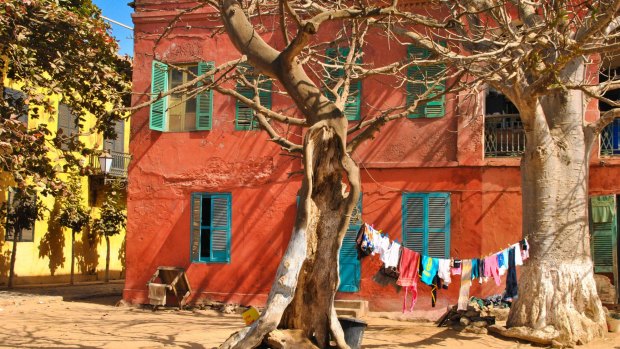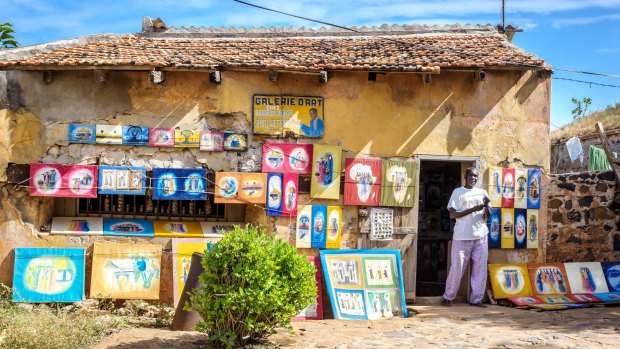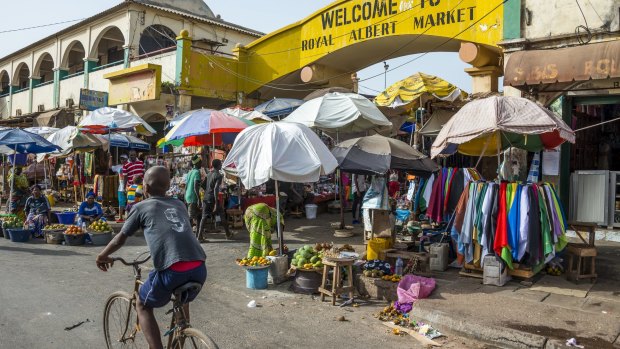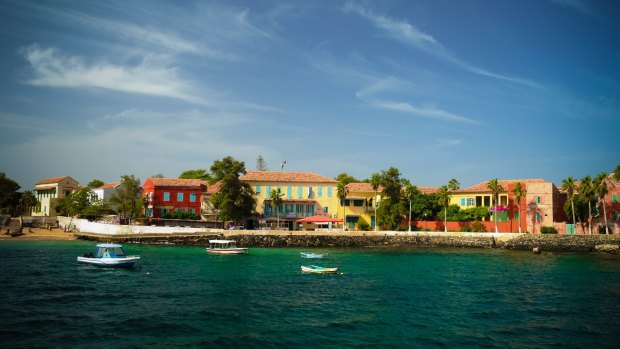This was published 6 years ago
Cruise West Africa: A Peregrine river cruise offers amazing insights into the history of slavery
By Catherine Marshall

Gorée Island was once the largest slave-trading centre on the African coast.Credit: Shutterstock
I'm standing at the Door of No Return. Ahead of me stretches the Atlantic Ocean, flat and blue and boundless. A soft breeze blows across from Senegal's mainland, chopping the water into whitecaps, blowing the hair from my face. Absorbing the day's benevolence, I conjure the people who passed through this doorway, a nondescript oblong cut from a mud house on the volcanic shoreline of Gorée Island – once the largest slave-trading centre on the African coast.
They'd been kidnapped from their villages all across West Africa, millions of men, women and children. Herded onto the island, they were stuffed into cells, picked over and purchased by slave traders, shackled and shuffled through this very doorway onto ships, stacked below deck and carried across that vast ocean all the way to the Americas. Bar a tiny number of freed and repatriated slaves, those who survived the journey would never see their motherland again.
My own launch onto the ocean from Dakar's wharves – a short ferry ride from Gorée – contrasts poignantly with theirs. Mine is a leisure expedition, a mind-broadening, perspective-changing journey through an Africa so very different from the one I know. It's an education in politics and history, people and language and culture – and a natural environment that's thoroughly unlike the African stereotype of thorn trees and Maasai warriors and livid savannah sunsets.

A Senegalese artist sells his paintings on the streets of Gorée Island, Dakar.Credit: Shutterstock
"This is going to be your best cruise ever," says guide Ibrahim Sanyang. "Because you're in West Africa, the happy place."
We cast off close to midnight on the M/Y Harmony G, a yacht sailing under engine power southwards along the Senegalese coast. There's nothing to see but a gentle black ocean dappled in moonlight. By morning, the sky flashes hot above the Saloum Delta, a UNESCO Biosphere Reserve, the tributaries of which burrow like tentacles into the sun-baked landmass. We take pirogues to the village of Djiffer, where fishermen sit in tethered boats laboriously untangling their nets.
"In Senegal, one minute is double that time," says local guide Khalifa Cessne as we wait – some of us impatiently – for an apparently endless herd of longhorn cattle to cross the road ahead of our bus.

A city market in The Gambia.Credit: Shutterstock
"In Senegal, we kill the time. In your country, the time kills you."
Such wisdom is exemplified by our driver, who scrubs his teeth with a root from the kola tree ("The Colgate tree," quips Cessne) as he waits for the cattle to pass. Local wisdom is typified, too, by the residents of Ile de Fadiouth, north of Djiffer, who take slow walks to the market and lay fish out to dry with unhurried devotion and chat idly in the shade of a baobab tree.
We reach this islet – made entirely of shells – via a wooden footbridge suspended above oyster beds. Women have shucked molluscs here since the fifth century AD, piling clamshells and cockle shells into a great compacted mound from which a whole city has now sprung. The houses are made from a shell-and-concrete composite; palm trees and minarets spring from calcified foundations. On a nearby islet lie the dead, Muslims and Christians alike interred in scalloped graves.

A view to the historic city at Gorée Island.Credit: Shutterstock
Overnight we sail into a new country, The Gambia, a narrow strip of territory tunnelling deep into Senegal's flank. These two nations were once conjoined and known as Senegambia; today, The Gambia – a former British colony – is enclosed almost entirely by its formidable, formerly French-colonial neighbour.
"We have the same tribes, the same ethnic groups and the same tribal languages," says Sanyang. "But when it comes to football, we are rivals."
The country's capital, Banjul, perches indolently on St Mary's Island in the mouth of the 1120-kilometre-long Gambia River. From the top of Arch 22, a triumphal structure commemorating the coup d'état of 1994, one can appreciate the precise geography of this guardian landform: ribbons of tar dissect its bulk; muddied roofs adorn its midriff; spangled ocean frills its shores. Democracy has been reinstated here following decades of dictatorship; the tourists are slowly returning.
These mostly European visitors tend to install themselves at beach resorts near Banjul; few venture up the snaking Gambia River and into the country's hinterland – so narrow it stretches out for little more than 20 kilometres on either side of the river before colliding with Senegal's border. Gliding upriver ourselves, we see not a single foreign soul; even human inhabitants are scarce.
But this compact mainland – a collage of savannah grassland, mongoose swamps, forests and rice fields – is crammed with an inordinate collection of wildlife: birds, reptiles, butterflies, spiders, monkeys, chimpanzees, crocodiles, hippos and dolphins, says guide Assan Saine. Birds are at their most multitudinous between October and April, when migratory species return from Europe.
"But we also have birds that stay here permanently," Saine says. "They have Gambian passports."
Such freedom of movement contrasts affectingly with the human stories that unfold along this waterway. We lay anchor at Fort James Island – latterly renamed Kunta Kinteh, after the Mandinka man who inspired Alex Hayley's celebrated book, Roots, and a UNESCO World Heritage site. Kunta Kinteh was captured in a village on the opposite riverbank, held on this island and shipped downriver, through the delta at Banjul and across the Atlantic Ocean.
The pathos suffusing this fast-eroding speck of dirt seems to follow us back into the pirogues, for they slosh with water on the choppy ride back to the yacht.
"You see the current of the river?" asks Saine as the boatmen from a nearby village try to stem its fury.
"If we left the pirogue alone it would be in Banjul by now."
Next day the riverbanks stretch out still and inscrutable, a jumble of baobab trees and termite mounds and flattened farmland. We take pirogues into Bao Bolong Wetland Reserve and glide through a drowned kingdom fringed with golden elephant grass and peanut weed striped orange and green.
This menagerie is aflutter with African darters and pelicans, bee-eaters and kingfishers and goliath herons with their metre-and-a-half wingspan. Sandpipers peck at crabs retreating into bubbling mud-holes; egrets snatch mud skippers less wily in their quest for freedom. Villages lie beyond the walls of foliage enclosing these swamps; their residents know the vagaries of the mudflats, Saine says: crocodiles wallow hereabouts, and if you get stuck in the sediment and there's no one around to help, you will almost certainly drown when the tide comes in.
The narrowing river is barely navigable by the time we reach the village of Kuntaur, and so we take a bus and then a ferry to Janjanbureh and find there an island awash with contradictory features: garrulous hawkers wrapped in the bright wax fabric so redolent of West Africa; wretched ruins attesting to this island's dark slaving history. Janjanbureh was yet another transiting station for those ill-fated souls captured around these uppermost reaches of the Gambia River.
To complete this voyage we must retrace our steps, and so we sail downriver to Banjul, through the gaping river mouth and back up the Senegalese coast to Dakar. It's dark as we glide past Gorée Island and slip into the city's port. I'm asleep, and so I miss the most confounding part of this journey: after striking out into new oceans and losing sight of the shore, we've been safely returned to this heartbreaking place of no return.
FIVE OTHER WEST AFRICA EXCURSIONS
BOABAB TREE
Climb inside this mammoth specimen in the Saloum Delta (about 23 metres wide), and you'll sense rotting leaf litter, cheeping bats and dust mites caught in shafts of light.
BABOON ISLAND
Rangers are the only people allowed onto this chimpanzee refuge in the Gambia River, but a cruise-by might elicit a sighting of these apes.
WASSU STONE CIRCLES
Thought to be a burial ground, this UNESCO-listed megalithic site in The Gambia remains remarkably untouched; those who disturb the stones will be cursed, local legend says.
SALT PANS
Locals dig holes on dry flats in the mineral-rich Saloum Delta, wait for the tide to fill them up and scoop encrusted salt from the surface as the water subsides.
KUNTAUR FILM FESTIVAL
Children from the remote village of Kuntaur experience their very own film festival, initiated by Ithaka Films and the Variety Foundation, and supported by guests on this cruise.
TRIP NOTES
MORE
Etihad flies to Abu Dhabi twice daily from Sydney and Melbourne, and once daily from Brisbane and Perth, with onward connections to Dakar via Nairobi or Casablanca with codeshare partners Kenya Airways and Royal Air Maroc. See etihad.com; kenya-airways.com/au; royalairmaroc.com
STAY
Doubles at the Pullman Dakar Taranga start from about $240, including breakfast. See accorhotels.com
CRUISE
Prices for Peregrine's eight-day Cruising the Rivers of West Africa journey start from $2620 per person sharing, with departures in January and February 2020. The cruise starts and ends in Dakar. See peregrineadventures.com
Catherine Marshall travelled as a guest of Peregrine.
Sign up for the Traveller Deals newsletter
Get exclusive travel deals delivered straight to your inbox. Sign up now.